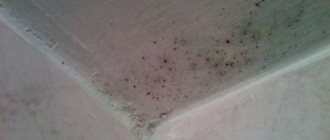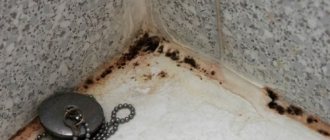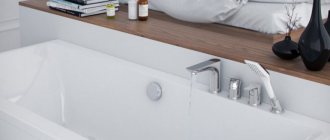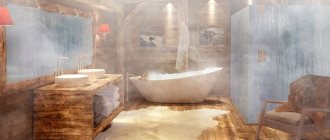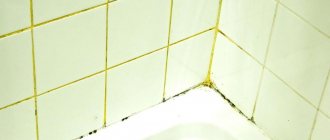The bathroom is designed to be used for water procedures, after which drops of moisture settle on the walls and other surfaces. In this room there is no sunlight, but on the contrary there is high temperature and humidity, and basically there is no normal ventilation. Accordingly, bacteria, mold and fungi actively multiply in it. As a result of the negative impact of these factors on the body, a person may develop bronchial asthma, allergic rhinitis and other diseases. It is necessary to take all measures to rid the bathroom of dampness.
Ventilation in the bathroom. Source: www.promklimat.ru
Causes of dampness in the bathroom
Dampness in the bathroom is most often caused by high levels of humidity in the room and poor ventilation. The moisture that accumulates in the air simply does not have time to disappear. The cause of dampness can be open containers of water in the room or a large amount of wet laundry that is dried in the bathroom after washing.
Among other things, the reasons include improper finishing without treating the walls with antifungal and antiseptic compounds, frequent flooding of the basement of the house and insufficient heating in the apartment. Humidity is increased by irregularities in the installation of equipment, defective building joints and poorly insulated external walls.
Most often, residents in corner apartments complain about high humidity. Here two external walls immediately touch the street. Corners often freeze and become damp. As a result, an unpleasant odor and mold appear, the wallpaper peels off, and the tiles fall off.
Common mistakes in dealing with excess humidity
- Apartment owners rely on ventilation. But weak air draft may not cope with high levels of humidity.
- Incorrectly installed forced ventilation system.
- Leaks in the water supply system, at the connections of plumbing equipment, and faulty faucets have not been eliminated.
- Poorly chosen finishing materials coupled with a lack of waterproofing of the room. As a result, the walls, ceiling, and floor absorb moisture. Over time they give it away.
- Cracks, holes or poor seals between the walls and sides of the bathtub. As a result, drops of water accumulate behind the bathtub or under it.
- The small size or ineffective operation of the heated towel rail prevents it from drying wet towels. Towels release moisture into the surrounding air.
- The bathroom or toilet is never ventilated.
- The bath mat is never or rarely dried
- The walls and floors of apartments on low floors absorb moisture from the soil through the foundation. The walls release this moisture into the atmosphere.
Mold and mildew are a consequence of increased dampness
Often, excess dampness and humidity, lack of air circulation lead to the appearance of fungus or mold. Black and gray spots, greenish or black coating spoil the aesthetics of the room and negatively affect the health of people and pets. The fungus leads to the development of allergies, respiratory diseases and skin problems.
Even if you regularly wipe the tiles or other finishes in the bathroom dry, moisture remains in the seams, under the ceiling and in other hidden places. Pay attention to the moisture that accumulates in the cup for storing toothbrushes, in the soap dish and other similar items. They are among the dirtiest things and places in the apartment.
To prevent the formation of mold and mildew, ventilate the room regularly. Wipe off moisture from shelves, floors and ceilings. Wipe down cups, soap dishes and other small items. It is important that moisture does not accumulate anywhere. If you are renovating a bathroom, do not forget to treat the walls, ceilings and floors with antiseptic compounds before laying tiles. If fungus does appear in the room, we offer several methods to combat mold.
Will repairs help?
Seeing dark spots, some people decide to carry out repairs by replacing damaged materials. It is worth considering that simply painting or plastering the surface will only solve the problem for a short time. Spores, through which the microorganism reproduces, can hide under any finishing material.
New repairs are recommended only if measures are taken to change the microclimate in the room. In this case, work must be carried out exclusively using protective equipment.
According to the laws of physics
The causes of condensation are closely related to the physical and chemical composition of the environment and its temperature. In science there is such a thing as air humidity. It means the amount of water in a vapor state. Different humidity, other things being equal, is due to different air temperatures: when it becomes higher, more steam can fit in it, and vice versa.
When the air cools, it can no longer hold as much liquid in the gaseous state. The “dew point” is reached - a temperature value at which part of the water vapor precipitates into condensate.
Another physical concept that regulates condensation is relative air humidity. The higher it is on the ground, the higher the dew point is located.
Consequently, condensation can appear even when the temperature drop is not significant. The opposite is also true: when the humidity level is low, condensation will occur only if there is a large temperature difference.
Where does condensation most often appear? Most often, dew falls on smooth, cold surfaces; they can be anything: metal pipes, glass surfaces, earthenware, ceramics, and even walls.
The occurrence of condensation almost always has negative consequences. The glass becomes dirty and ceases to be transparent, fungi, pathogenic microorganisms and mold multiply on the walls, causing dangerous diseases, and rust appears on the pipes. These consequences of condensation in the house are quite difficult to deal with; it is better to prevent them in advance.
Read here: How to sew curtains - tips and instructions for sewing and pattern selection for beginners (95 photos)
On the toilet cistern
An unpleasant effect is caused by the appearance of condensation on the toilet tank. The toilet seems dirty and out of order. Fogging could be caused by various factors, and they also need to be addressed differently.
Read here: How to clean a cauldron from carbon deposits: instructions for quickly and effectively cleaning a cast iron and aluminum cauldron at home and on the go
Here are some effective ways to get rid of condensation:
Install a toilet with an anti-fog function. The secret of such models is that the tank has double walls. But the price of these products almost doubles.
Check to see if the locking mechanism inside the tank has failed. If the system is faulty, cold water constantly leaks into the toilet, and the water in the container does not have time to heat up, cooling the walls of the tank. In this case, you need to repair the fittings in accordance with the toilet manufacturer's instructions.
Insulate the walls from the inside. To do this, you need to choose thin moisture-resistant insulation - foamed polyethylene and similar types. Remove the tank, remove all the insides, glue the parts prepared from the templates from the heat-insulating material, coat the joints with sealant, and let dry. Install the fittings back into the tank and return it to its place.
Insert the plastic insert. This is a simpler version of the previous solution. You need to purchase a container of a suitable size, make all the necessary holes, and select rubber gaskets for tightness. You should end up with a system of two tanks, with a gap between them of about 2 mm.
Getting rid of condensation forever
We determine the “enemy” that we will have to deal with – penetrating dampness or condensation. To do this, we place a small piece of foil taped around the edges on a damp surface, and after 2 days we look at where the moisture appears: if on top, it means condensation, on the bottom – penetrating dampness.
We eliminate the main causes of condensation: - high humidity indoors, - poor thermal insulation of the ceiling.
Elimination of high humidity indoors
The problem of excessive humidity inside a living space is always a problem of insufficient ventilation. To solve this, a hood is placed above the kitchen stove, and an exhaust fan is installed in the bathroom, the required performance of which is determined by multiplying the volume of the bathroom by 20 (we get the volume of air exchange in cubic meters).
Let us note that in Soviet-era apartment buildings, the building's common access ventilation shafts are, as a rule, clogged from top to bottom with dust and fragments of brick and concrete. It makes sense to force the management company to bring these shafts into working order - it is quite possible that then the installation of an exhaust canopy and additional hoods in the bathroom will not be necessary.
It is also worth noting that the reconstruction of a balcony or loggia and the installation of packaged plastic windows on them also lead to the need for additional exhaust ventilation - any, no matter how frequent, ventilation of these rooms will not solve the problem of condensation formation.
Obviously, you can reduce the moisture content in the room without any special expenses if you: - cook food with an open window or vent and the door to the kitchen closed; - close the doors to the bathroom when using it and, if possible, ventilate all rooms after taking a shower and while washing and drying clothes; - do not use living rooms for drying washed linen or wet clothes; when using heating radiators for this purpose, be sure to ensure their constant ventilation.
Elimination of ceiling insulation defects
Unfortunately, most often the formation of condensation in rooms is caused not so much by our mistakes in their operation and poor quality of ventilation, but by the absence or poor quality of thermal insulation of the ceiling and walls.
Solving this problem, if we are talking about a garage, country house, country house or its basement, is not cheap and labor-intensive, but it is possible. If we talk about an apartment in our ordinary multi-storey buildings, it is impossible: it is only possible to reduce the risk of negative consequences of this inevitable process.
In any case, a person who is faced with the problem of condensation formation, which has already become threatening, should take into account that it can only be solved radically, namely, by dismantling the old and installing a new thermal insulation structure. Foam and other insulation materials made from special, including genetically cloned materials provide a truly excellent effect - they are extremely easy to use, very expensive, which is natural, but effective - for 2, maximum 3 years there will be no problems with condensation, then they will become a disaster .
Unfortunately, another way to solve the problem is also not cheap (it all depends on the cost of the materials used and additional work), but it is durable - this problem cannot be solved in principle for centuries, but for decades it can be solved. The essence of this solution is to install or replace ceiling insulation. The thermal insulation is of poor quality - therefore, it must be changed, and completely. Thermal insulation technologies are known and are determined by the material used for it and the type of ceiling (it can be suspended or hemmed - it is clear that in multi-storey buildings - only hemmed); in this case, all previous linings up to the floor slab are removed.
Any work of this kind does not require, say, detailed schematization, as in the case of laying stoves or fireplaces, but is still carried out in a strictly defined sequence, especially in multi-story buildings. In addition, it should be borne in mind that if the house that you are going to put in order is yours, then there will be no problems with permission to remodel it, but if you have neighbors below and above, be careful - your renovation may affect the quality of their housing is negative, and you will pay for it.

